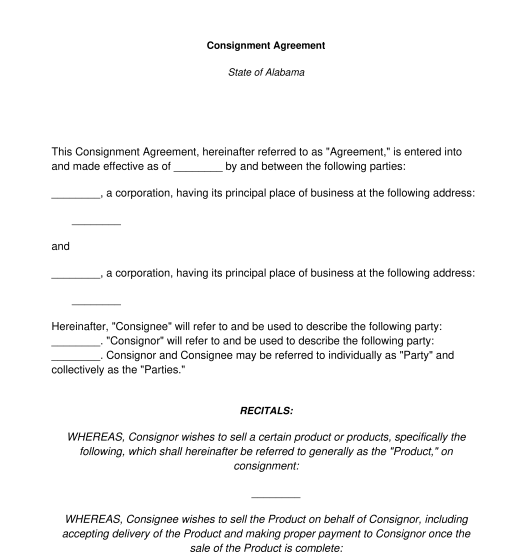 09/10/2025
09/10/2025

Answer a few questions and your document is created automatically.

Your document is ready! You will receive it in Word and PDF formats. You will be able to modify it.




Rating: 4.8 - 431 votes
Download a basic template (FREE) Create a customized documentA consignment agreement is a document used when one party, known as the consignee, agrees to sell goods on behalf of the other party, known as the consignor in exchange for compensation. The consignor is the person to whom the goods belong. Often, this is just an individual looking for an easy and quick way to sell goods. The consignee is the person who is permitted to sell the goods on behalf of the consignor. Typically, this is the storefront or business that runs specifically for this reason — most are called consignment shops.
Consignment agreements can be drafted for any sort of consignment sale between two parties. They can be used to sell just one product or a series of products. This arrangement is mutually beneficial because the consignor does not need to do the work of the sale themselves, and the consignee gets a portion of the profits or a fee for arranging the sale.
Though both of these documents are used to facilitate sales arrangements, they involve different responsibilities and logistics with the involved parties. In a consignment agreement, the consignee takes possession of the goods that are being sold. They are responsible for marketing and displaying the goods and handle the entire sale. The consignor then receives a portion of the profits when the final sale is made. Examples of a consignee would be an art gallery or consignment shop.
In a broker agreement, the broker does not take possession of the goods that are being sold. Though they connect buyers and sellers, they generally do not negotiate the sale and are less involved in the transaction than a consignee would be. Examples of a broker would be a real estate broker or a stockbroker.
No, it is not mandatory to use a consignment agreement. A consignor and consignee could have an informal understanding without creating a written contract. However, it is highly advisable as it makes sure that both the consignor and consignee have a clear idea of the services that will be provided and the terms under which this will happen. It acts as protection for one or both of the parties in case there is a problem or future dispute related to the arrangement.
In the context of a consignment agreement, exclusivity means that the consignor is not free to hire any other consignee to arrange sales for them while this agreement is in place.
Both individuals and businesses may enter into consignment agreements. For individuals entering into consignment agreements, they must be of legal age to enter into a contract, 18 years of age or older in most states. They must also be mentally competent to enter into a contract. Business entities entering into a consignment agreement must have the legal authority to do so, usually outlined in the business' governing documents, such as bylaws or operating agreement.
When the consignment agreement is written and all the relevant information has been included, each of the parties should sign and date the document. The parties should each keep a copy of the agreement for reference and in case of future dispute.
The parties may choose to include photos of the specific goods that the consignee will be selling on behalf of the consignor. This way, there is a record of their condition when they enter into the possession of the consignee.
A consignment agreement must include at least the following mandatory clauses:
In addition to the above mandatory information, the following information may also be included:
Consignment agreements in the United States are subject to both federal laws and specific state laws, which cover general contract principles like formation and mutual understanding.
Federal laws may restrict what services can be contracted for (for example, you may not contract for a consignee to sell anything illegal) and certain broad categories, like contracting for something that looks more like a business partnership than a consignor/consignee relationship.
Individual state laws may govern the interpretation of the contract in case of a dispute. Consignment agreements are also covered under Article 9 of the Uniform Commercial Code.
You fill out a form. The document is created before your eyes as you respond to the questions.
At the end, you receive it in Word and PDF formats. You can modify it and reuse it.
Consignment Agreement - FREE - Template - Word and PDF
Country: United States